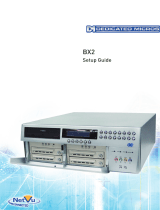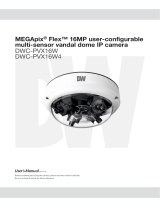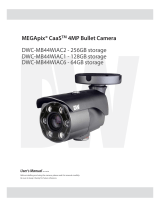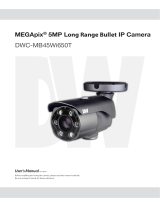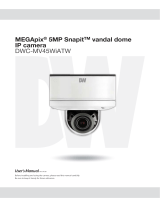Page is loading ...

1.0001
Eco Range
Network Guide

Dedicated Micros ©2006
2
Eco
Contents
Network Configuration ................................................................................................................3
Simple Configuration ..................................................................................................................5
Advanced Configuration ...........................................................................................................13
Tools ...........� 26
Reviewing the Unit Logs ...........................................................................................................27
Appendix A .� 31
Appendix B – .ini Files ..............................................................................................................32
Appendix D –Unit Serial and Network Cables ........................................................................36
Appendix E – IP Address Range and Subnets .......................................................................38
Index ...........� 42

Dedicated Micros ©2006
3
Eco
Network Configuration
This manual is designed to help with the advanced configuration of the unit using the on-board web
pages.
To assist with the configuration of the unit, sections are constructed as tutorials and will illustrate how
to perform common requirements. Use the tutorials that will provide the required functionality and
follow the step by step instructions.
In some of the sections the web interface and the OSD menus will be displayed. These are the more
advanced network settings where configuration via the web pages is more appropriate.
This manual will be divided into:
Simple Configuration –required to get the unit up and running
Advanced Configuration –project specific requirements
Note: The unit should be configured in line with the main configuration steps detailed in the Setup
Guide and therefore the cameras inputs have been enabled and the standard record rate
has been set.
1.1001
Web Page Icons
Each of the unit configuration web pages has the following buttons:
1.1002
Reset to Defaults –This will return the associated page to factory defaults.
1.1003
Display Help –This will display the Help pages for the associated configuration page. This is a good
starting point if you are having problems or do not understand the configuration parameters.
1.1004
Save Settings –This will save a changes that has been made to the configuration page - remember
to save the changes.
NOTE: Selecting a new page before saving the changes will result in any changes being lost!
1.1005
Reset –This is displayed on configuration pages that require a unit reset to initiate a function.
Note: Always save the settings before resetting the unit.
1.1006
Each ‘How to.. Section’ will show the Tab and Function name to allow easy location of the correct
configuration page.
1.2001
Accessing the Configuration Web Pages
The unit is configured using on the on-board web pages. To access these:

Dedicated Micros ©2006
4
Eco
Note: The unit should already have been configured with an IP address (via the serial port or the
OSD menus) and connected to an Ethernet network.
1. Launch Internet Explorer (or Netscape Navigator).
1.2002
2. Type the IP address of the unit into the address bar.
3. The Main Menu page will be displayed.
4. Select Configuration Options. The unit will prompt for a username and password. The
default settings are dm and web respectively.
Note: The user name and password are case sensitive; they should be changed from the default
username and password and kept safe. Mislaid usernames and passwords could result in
the unit being returned to Dedicated Micros for resetting.
1.3001
Main Menu
The unit Main Menu allows the Operator access to:
Live viewing of any of the connected cameras.
Configuration web pages for the unit.
Downloads which include the software applications and the product documentation.
Demo pages that demonstrate how viewing applications can be designed for varying system
requirements.
1.3003
2.0001

Dedicated Micros ©2006
5
Eco
Simple Configuration
How to Configure Global Parameters
There are some parameters that can be set that will affect the overall system; video standard for the
video inputs, browser format for the web interface, language that the menus will be displayed in and
the DST (daylight saving time) settings.
To configure these parameters:
1. Select Home -> Main Set-up.
2. Select the video standard from the drop down list; this will be the standard for all the video
inputs on the unit.
Note: It is necessary to carry out a system reset if the video format is changed before saving the
settings. This allows the unit to activate the change.
3. Select the date format from the drop down list.
4. The unit web pages can be viewed in two formats; Active X (default) or Java, select the
relevant option from the drop down list.
5. The web configuration pages for the unit can be displayed in a selection of languages,
select the language which is most appropriate to your installation from the drop down list.
Note: Ensure the PC being used for the configuration is set to the correct time zone and that DST
is enabled before continuing.
6. Select the DST for region where the unit is installed from the drop down list.
7. If the settings are incorrect reset the unit by selecting the reset button.
8. If the unit time is to be synchronised to the PC that is being used to configure the system
then select sync unit time from PC. Note this only synchronizes the time when the button is
selected this will not maintain synchronisation permanently.
9. Remember to save the configuration by selecting Save Settings!
2.0003

Dedicated Micros ©2006
6
Eco
Function Description
Video Standard This displays the standard used by the video inputs on the unit.
Date Format It is possible to identify the format in which the date will be
displayed in the browser; the default setting is Day Day, Month
Month, Year Year.
Browser Settings The browser interface supports ActiveX or Java. Select the most
appropriate for your application from the drop down box. This
is a global setting so any user connecting to the system will be
presented by the same interface.
Language The unit configuration pages can be displayed on the local
browser in the most appropriate language.The currently
languages supported are; English, Spanish, French, Czech,
Italian, Russian, Dutch, Portuguese, German, Turkish, Croatian,
Danish, Finnish, Norwegian, Hungarian, Swedish, Polish, Arabic
and Chinese
DST Daylight Saving Time. This is the time zone local to the unit, select from the list for the
most appropriate time
Reset This will reset the unit
Sync unit time The unit can be synchronised with the PC that is being used to
configure the unit. If the PC is synchronised with the network clock
then this time will be reflected in the unit. The synchronisation is
not persistent and will only synchronise the unit and the PC at the
time the button is pressed
2.20011

Dedicated Micros ©2006
7
Eco
How to Configure Video Inputs and Standard Record Settings
Each of the video inputs on the unit can be individually configured.
This section will describe the full configuration process including resolution and file size, camera
titles, setting a camera to mono, camera fail notification and standard recording settings.
1. Select Cameras -> Camera Set-up
2. It is possible to identify the global camera resolution (common to all video input) the current
option sets the resolution to 704 x 256.
3. Select the required image resolution, enter a file size of between 2K & 45K.
Note: See the Setup Guide for the recommended settings.
4. All connected cameras will be automatically enabled, use this screen to check the enabled
inputs are correct.
5 In the corresponding title box enter the camera name for the video source connected to that
input.
6. Use the drop down box to select whether alarm input polarity is Normally Open, Normally
Closed or Off for each camera alarm.
7. By default the unit presumes all enabled inputs are colour video sources. If you are
connecting a monochrome signal to the unit, it is recommended that the input be set for
mono. Place a tick in the corresponding video input.
8. To enable the unit to send notification that the video input does not detect a 1V peak to
peak signal place a tick in the box below Cam-Fail Reporting. This can send a camera fail
email.
9. Save the configuration by clicking the Save icon.

Dedicated Micros ©2006
8
Eco
Function Description
Pictures/Second / milliseconds This allows the record settings to be configured as either Pictures
Per Second or Milliseconds
Live/Record Resolution
This is the resolution of the live and recorded images (MPEG only)
that will be transmitted from the unit and recorded to hard disk.
Image Size This is the file size for the image to be recorded, between 2KB &
45KB.
Video Expiry Period This indicates the maximum time any images can be stored on the
hard disk, if the record duration is greater than the video expiry
period the images will automatically be overwritten
Connected The unit can automatically detect if a camera source is present,
the corresponding input will be enabled in this menu for connected
cameras.
Title It is possible to allocate an ASCII camera title to each of the
cameras, which will be displayed onscreen along with the camera
number.
Alarm Input Polarity
This can be set to Off, Normally Open (NO) or Normally Closed (NC).
Mono If the video input on the unit has a black and white (monochrome)
source connected then enable the corresponding camera.
The unit will try and compress the colour contents of the image if
this box is not enabled, ticking this box will remove unnecessary
overhead on the compression process.
Camera Fail Reporting If the video input on the unit does not identify a 1V peak-to-peak
signal then the unit can transmit an alarm notification email for
camera failure on the corresponding video input.

Dedicated Micros ©2006
9
Eco
Click here to see thumbnail images
This will display a thumbnail view of video connected to the unit.
Place the cursor in the camera title box to view the corresponding
video input.
2.20021
To configure the standard record settings
10. The record duration and standard record rate are inter-connected; changing one of these
settings will automatically update the other.
11. Enter the information in either the record duration or standard record rate. These are global
settings across all cameras for the schedule period being edited.
Either
Enter the Record Duration for when the unit in the selected schedule period
Or
Enter the Standard Record Rate for the selected schedule period.
12. Select the alarm recording mode to reflect the recording requirement on receipt of an alarm.
13. Select the Event Active option from the drop down list
Note: Running the unit at maximum Record Rate (25pps or 40ms in Standard Record Settings)
will affect viewing and network transmission, as the video codecs will be operating close
to capacity - the unit’s priority is to record the footage to the internal HDD, so transmission
performance will be reduced. This is exhibited by slow connection to the html pages and
reduced viewing frame rates. Multi-user viewing will also be affected. It is not recommended
to set the Standard Record rate to 20ms for everyday usage, but rather only for specific
situations where this rate is necessary.
Record Duration The total record time available in (DD) Days and (HH) Hours. This
indicates the storage capacity of the system without any alarm
recording. It is estimated from size of video storage, the standard
record rate and the requested target size of the recorded images.
Note: Changing the Record Duration will automatically update the
Standard Record Rate. Changing the Standard Record Rate will
likewise update the Record Rate. This should be configured for
day, night and weekend operation modes.
Standard Record Rate This is global setting and identifies the ‘common pictures per
second’ for all enabled video inputs in non alarm mode. This can
be set in milliseconds or the number of pictures per second.
The delay between consecutive images from any one camera is
the Standard Record Rate multiplied by the number of cameras
being recorded. Changing the Standard Record Rate will
automatically update the Record Duration. Changing the Record
Duration will likewise change the Standard Record Rate.
Example Record Rates 40ms = 25 pictures per second
50ms = 20pps
100ms =10 pps
125ms = 8pps
200ms = 5 pps
500ms = 2pps
1000ms = 1pps
Alarm Record Rate This identifies the alarm recording rate, for the mode of operation
being configured (i.e. Day, Night and Weekend mode), which will
be activated if an alarm is triggered on the unit. For example, the
unit may be configured to increase the recording rate when a door
contact is triggered.
Event Active This identifies what kind of alarm will trigger the alarm record
rate to activate. It is selectable between None, Alarms, Activity, or
Alarms and Activity (both).
2.20022

Dedicated Micros ©2006
10
Eco
The unit supports day, night and weekend operation, if this has been enabled then it is possible to
schedule changeover times between Day, Night and Weekend operation.
The different settings for Day, Night and Weekend operation allows the system to be set to not
record during the one period (e.g. Night = 0pps) until an event triggers Alarm recording.
12. Enter the record rate for the Day, Night and Weekend modes, these settings will then be
applied to all cameras enabled within these modes.
13. Save the settings by clicking on the Disc icon.
2.3003

Dedicated Micros ©2006
11
Eco
Configuring the Network Settings of the unit
The Quick Start Guide gives details of how an IP address can be allocated to the network port on the
unit to allow you to communicate via a LAN or WAN from a web interface.
This section details these additional configuration parameters.
To configure the network information
1. Select Network -> Network Settings
2. The IP address, subnet mask and default gateway will be displayed on this page.
3. The unit supports Domain Name Server (DNS) allowing the unit to reference other hosts
by their name rather than their IP address, enter the IP address of the primary DNS and
secondary DNS server
4. The default system name for the unit can be changed to something appropriate by editing
this section
5. The unit has an auto-detecting 10/100BaseT network connection. Place a tick in the ‘Force
10BaseT operation’ if the unit is to be connected to a 10Mbps edge switch or hub
6. Remember to save the configuration by selecting Save Settings!
Function Description
IP Address, Subnet Mask, etc These are the settings that have already been configured via
the Serial port or OSD menus. This is the static IP address and
subnet mask, and if applicable default gateway.
Primary DNS This is the primary DNS server IP address for applications that are
utilising domain names.
Secondary DNS This is the IP address of the secondary DNS server in case of
failure of the primary server.
System Name This is the name that is allocated to the unit.

Dedicated Micros ©2006
12
Eco
Base PPP IP This is the base PPP address that is allocated to the system. This
will be automatically allocated to PPP IP : Link 1
PPP IP : Link 1 This is a read only section and will take the information configured
in the Base PPP IP section as it’s IP address
PPP IP : Link 2 This is the IP address allocated automatically for PPP. This is the
next IP address in line taken from the Base PPP IP address, e.g.
base PPP IP 10.0.0.1, PPP IP Link 2 10.0.0.0
DHCP IP If the unit is to be installed in a DHCP network, this option would
display the IP address that was automatically allocated to the unit
from the DHCP Server.
DHCP Subnet If the unit is to be installed in a DHCP network, this option would
display the subnet that was automatically allocated to the unit
from the DHCP Server.
DHCP Gateway If the unit is to be installed in a DHCP network, this option would
display the gateway that was automatically allocated to the unit
from the DHCP Server.
DHCP Name This would be the name of the unit that is automatically allocated
by the DHCP server.
Serial Number This a read only section and is generated by the unit hardware
identifying the serial number of the unit.
LAN, WAN, ISDN This option ensures the speed of the data from the unit matches
the speed of the network the data is being transmitted across.
These are default settings and are configured as:
LAN – 10000 Kilobits/second
WAN – 256 Kilobits/second
ISDN – 64 Kilobits/second
Force 10BaseT operation The unit supports 10 or 100BaseT half duplex transmission, this
will force the unit to operate at a 10BaseT connection.
Max Trans Rate This is the maximum transmission speed for the network.
Transmit Image Buffers This is used in order to improve the picture delivery over Ethernet
when using a slow connection, i.e. 256Kbps. Options available
are 1, 2 or 3 buffers.
Ethernet MTU This is the maximum transmit unit for the Ethernet packet. The
MTU is the largest physical packet size measured in bytes,
that the network can transmit. By default this figure is set to
1500bytes.
TCP Re-Transmit Timeout This is the time the unit will wait to re-send a packet if an
acknowledgement is not received. When making a connection
across a WAN link this figure should be increased and should
match the timeout figure for the router.
PPP Idle Line Timeout This is the time the unit will wait before dropping the PPP link if
data has not been transmitted or received.
PPP Link Down Timer If for any reason the PPP connection is lost then this is the time
period before the unit will be forced to drop the PPP connection.
Packet Size This is the maximum packet size that will be transmitted from the
unit. This figure is identified in Bytes.
Secondary Web Server Port It is possible to configure a secondary web server port if
the default is being utilised already. To view the unit via this
connection, the address typed into the browser would be http://<IP
address of the unit>:<Secondary Web Server Port number>
3

Dedicated Micros ©2006
13
Eco
Advanced Configuration
3.00091
How to configure a Schedule
The On-board schedule function of the unit is designed to program recording rates. This makes it
possible to record at different rates depending on the time and day, saving disk space when a high rate
of recording is not necessary. These rates are set up on the Camera Set-up page.
To set up the Schedule function, we will use a typical example:
Monday to Friday Day recording settings in use from 08:30 until 18:30
Monday to Friday Night recording settings in use from 18:30 until 08:30
Weekend Saturday uses Day recording settings from 07:00 until 22:30,
Night recording from 22:30 until 10:00 on Sunday. Sunday records
using Day settings until 18:00, then switches to Night recording
until 08:30 on Monday.
3.00092
1. Enter 18:00 in the Night box adjacent to Sunday
2. Enter 10:00 in the Day box adjacent to Sunday
3. Enter 18:30 in the Night box adjacent to Monday through to Friday
4. Enter 08:30 in the Day box adjacent to Monday through to Friday
5. Enter 22:30 in the Night box adjacent to Saturday
6. Enter 07:00 in the Day box adjacent to Saturday
7. Alternatively, if the premises are vacant at the weekend and a different set of settings are
appropriate, enable the weekend settings and enter a time for the weekend to start and
end.
8. Enter the titles that will be associated with the operating modes
9. Save the configuration by selecting Save Settings!
10. If times have been changed, press the Reset button to apply the changes.
3.00093

Dedicated Micros ©2006
14
Eco
Function Description
Schedule This is a seven day schedule that shows when different recording
rates will be applied.
NIGHTTime This identifies the time when the unit will switch to Night operation
mode.
DAYTime This identifies the time when the unit will switch to Day operation
mode.
Weekend Enabled Enabling this option will switch the unit to weekend mode settings
at the day and time selected.
Weekend Start / End This identifies the time period when the unit will be in weekend
operation mode and weekend settings will be applied.
Operation Mode X Title This allows the operator to assign a suitable name to each mode
of operation.
3.2101

Dedicated Micros ©2006
15
Eco
How to Configure Activity Detection
The unit supports activity detection on all video inputs, which allows cameras to automatically detect if
there is any movement within the video scene.
This can then trigger a number of operations such as email an alarm notification and increase camera
recording rate for the corresponding video input.
Configuration will be separated into two sections:
Enabling video inputs
Setting up the detection area
3.2104
To set up each camera with a grid:
1. Select Alarms/Activity -> Activity Detection
2. Enable All or individual inputs for Activity
Function Description
Activity Camera Enable This option will enable ACT on the adjacent camera. Tick the box
that corresponds to the input to have ACT enabled
3. Click on ‘Click here to see Activity’ to display the video image and grid. By default, video
input 1 will be displayed and the grid is divided into 16x16 zones
4. Select the video input you are configuring from the drop down menu
5. If the default areas are not positioned correctly there is an option to clear all cells
6. Click on individual cells to make detection active. Click again to make the zone inactive.
7. If you want to use the default zone settings, select the default grid option to place 16x16
zones over the image.

Dedicated Micros ©2006
16
Eco
3.2105
Function Description
Camera This is a drop down list of the video inputs on the unit, selecting
one of the inputs will display the corresponding video source
Clear Cells Removes all defined zones from the image
Default Grid Displays the default grid of 16x16 ACT zones over the whole
image
Sensitivity This selects which of the five levels of sensitivity will be applied
to that camera. The available settings, from highest sensitivity to
lowest are Indoor high, Indoor Low, Outdoor high, Outdoor Low
and Very Low.
Refresh This will update the reference image to the latest view during
setup

Dedicated Micros ©2006
17
Eco
3.310
How to Protect Global Alarm Recordings
The Eco9 supports 10 alarm inputs of which 9 are preconfigured to the cameras; alarm input 17 is the
Global alarm.
The Eco16 supports 17 alarm inputs of which 16 are preconfigured to the cameras; alarm input 17 is
the Global alarm.
To enable and configure the Global Alarm:
1. Select Alarms/Activity -> Global Alarm
2. Alarms can be protected from being overwritten indefinitely. Tick the box to protect Global
Alarms
3. Enter the time period prior to the alarm that you wish to save along with the incident for
review with the incident, into Pre Alarm Protection
4. Enter the time period for the alarm duration (this includes the pre-alarm period); this is the
time period that will be protected from being overwritten.
5. Remember to save the configuration by clicking the save icon!
3.3102
Function Description
Protect Global Alarms This checkbox will allow Global alarms to be protected indefinitely
until they are manually deleted.
Pre Alarm Protection This is the time period prior to the ACT trigger that will be saved
along with the ACT recording. These images will be available for
archive and will be protected from being overwritten.
Post Alarm Protection This is the minimum time period from the start of the ACT trigger
that will be protected from being overwritten. This time will include
the ACT recording and any post alarm recording but will not
include the pre-alarm images
3.3103
Note: When protecting an image it is important to remember that the unit saves files in 50
Megabyte blocks, the whole block that contains the image will be protected. If the image
overlaps into another block the all associated blocks will be protected this can start to
reduce the hard disk capacity available for storing images.
3.6003

Dedicated Micros ©2006
18
Eco
How to Configure Email Settings
The unit can automatically transmit and e-mail to an SMTP Server under numerous conditions,
including on start up of the unit, on receipt of an alarm, or camera failure.
This allows the unit to be installed in unmanned applications where a Remote Monitoring Station (or
Manager, etc) would be notified, by e-mail, if any of these conditions occur.
To configure the settings to allow e-mails to be transmitted:
1. Select Network -> Email.
2. The feature must be enabled to work. Click the ‘Enable Email’ checkbox to enable or
disable the feature.
3. Enter the connection profile; this can be Ethernet if the e-mail is to be transmitted over the
LAN or WAN or named profile if using a dial up connection.
4. Enter the IP address or the DNS name of the SMTP Server the e-mail will be sent to.
5. Enter the e-mail address that the SMTP server should forward the e-mail to.
6. If applicable enter the display name for the e-mail address.
7. Enter the e-mail address that the recipient is to reply to. This is only applicable if a reply is
required and MUST be filled in for this to happen.
8. If applicable enter the display name of the reply e-mail address.
9. It is possible to identify where the e-mail has be sent from. This is optional and if this is left
empty, the video server will use the system name & DNS name to create a sender name.
Note: The unit can not receive e-mail replies but this must be a valid e-mail address for an SMTP
Server.
10. The unit can be forced to send an e-mail under numerous conditions including start up of
the unit, on global alarm, camera failure, camera related alarms and activity. Place a tick
against the actions that are applicable to your systems functional requirements.
11. Save your configuration by selecting Save Settings!
3.9003

Dedicated Micros ©2006
19
Eco
Function Description
Enable Email This will switch the function on or off.
Connection Profile It is possible for the e-mail to be transmitted via the Ethernet
network or dial up connection. This setting presumes that a
modem has been connected and configured and the unit is
connected to a LAN or WAN and allocated a valid IP address
Mail Server This is the IP address or DNS name of the SMTP Server that the
e-mail from the unit will be sent to. The SMTP server will then
forward this onto the recipient
Recipient This is the e-mail address and display name of the intended
recipient of the e-mailed image
Reply to This field must be configured if the recipient is to reply to an
e-mail. The unit does not accept e-mails so this must be a valid
e-mail address
Sender These optional fields indicate the source of the e-mail notification.
If the fields are left blank the unit will use the system name
& DNS Email reports This enables the user to select which
conditions will generate an email report, and allow selection of the
accompanying image to be sent in the email. It is also possible
to select whether Activity or Alarm event from each camera will
generate an email, or select all cameras for Activity or Alarm.
Email Reports This creates an email for each system, start-up, global alarm and
camera fail.
Activity/Alarm Each camera can be individually selected to send an email when
there is either Activity or Alarm or both. Click on the appropriate
checkbox to enable or disable each option.
4.00011

Dedicated Micros ©2006
20
Eco
How to Protect or Un-protect Images
Images stored on receipt of an alarm can be automatically protected within the corresponding alarm
configuration page.
In addition it is possible to protect images that are stored on the hard disk and have not been
protected, or increase the time period allocated for protecting the image.
Alternatively it is also possible to highlighted protected recordings and un-protect these so they can be
overwritten.
To protect existing recorded images:
1. Select Alarms/Activity – Alarm Image Protect/Unprotect, If there are any existing protected
images these will be displayed within the protect image partition summary.
2. Enter the start and end time and date and select Protect Images to display the
corresponding recordings.
3. Highlight the recorded file in the protect image partition summary.
4. Enter the time period that images are to be protected in the protect image option or select
protect images indefinitely for these never to be overwritten.
4.00021
To unprotect existing protected images:
1. Select Alarms/Activity – Alarm Image Protect/Unprotect
2. If there are any existing protected images these will be displayed within the protect image
partition summary, enter the start and end time and date to display the corresponding
recordings
3. Highlight the recorded file in the protect image partition summary
4. Select un-protect images, this will remove the protection from the files, release the hard disk
space these files where stored in and the files will now be overwritten.
/
